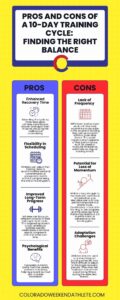When it comes to finding or designing an effective training program, there are various approaches to consider. One such method gaining popularity is the 10-day training cycle. In contrast to the traditional 7-day cycle, this approach allows for more extended recovery periods and more flexibility in scheduling workouts. To shed light on this training methodology, we will explore the pros and cons of a 10-day training cycle.
Pros of a 10-Day Training Cycle:
Enhanced Recovery Time:
One of the primary advantages of a 10-day training cycle is its extended recovery time. Intense workouts can lead to fatigue and an increased risk of injury if adequate rest is not incorporated. Extending the cycle by three days gives athletes more time to recover and repair their muscles, reducing the likelihood of overtraining. This additional recovery time allows for better adaptation to training stress, enabling athletes to perform at their best during subsequent workouts.
Flexibility in Scheduling:
The 10-day training cycle offers greater flexibility in scheduling workouts. This is particularly beneficial for athletes with busy lifestyles or unpredictable work schedules. With a longer cycle, athletes can adjust their training days to accommodate personal commitments or unexpected events without compromising the overall training plan. This flexibility can reduce stress and enhance adherence to the training program, ultimately leading to better long-term results.
Improved Long-Term Progress:
By incorporating longer training cycles, athletes can focus on different aspects of their training in each cycle. For example, they can dedicate one cycle to building endurance, another to speed work, and a third to recovery and injury prevention. This targeted approach allows athletes to address specific weaknesses and make steady progress in different areas over time. By periodizing their training in this manner, athletes can optimize their performance and achieve their long-term goals.
Psychological Benefits:
The extended duration of a 10-day training cycle can have positive psychological effects on athletes. It provides a mental break from the weekly routine’s monotony, helping prevent burnout and maintain motivation. Athletes may feel refreshed and excited to tackle their next training block, knowing they have had a longer recovery period. This psychological boost can lead to improved focus, determination, and better performance.
Cons of a 10-Day Training Cycle:
Lack of Frequency:
One potential drawback of a 10-day training cycle is the reduced frequency of workouts. With fewer workouts per week, athletes may experience a decrease in the volume of training they can accomplish within a given time frame. This could impact certain aspects of their performance, such as speed or muscular endurance, which rely on regular training stimuli. It’s essential to carefully plan and structure workouts to ensure sufficient motivation is provided despite the reduced frequency.
Potential for Loss of Momentum:
In a longer training cycle, there is a risk of losing momentum or consistency. Athletes may struggle to maintain the same level of motivation and discipline over a 10-day period compared to a shorter cycle. Consistency is crucial in training to see progress, and the extended time frame may lead to a dip in enthusiasm or adherence to the training plan. Athletes must actively work to stay motivated and accountable during this extended cycle.
Adaptation Challenges:
The extended recovery time provided by a 10-day training cycle can be beneficial but also present challenges. Athletes who are used to a more frequent training schedule may find it difficult to adjust to the longer recovery periods. They may feel restless or concerned about losing fitness during the extended breaks. Monitoring performance and making necessary adjustments is important to ensure that the longer recovery periods are not hindering progress.
The 10-day training cycle offers several advantages, including enhanced recovery time, flexibility in scheduling, improved long-term progress, and psychological benefits. However, it is important to consider the potential drawbacks, such as reduced training frequency, potential loss of momentum, and adaptation challenges. Every athlete is unique, and what works well for one individual may not be suitable for another. Ultimately, adopting a 10-day training cycle is up to your fitness goals.








